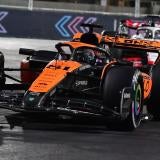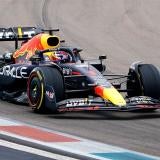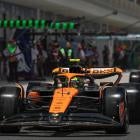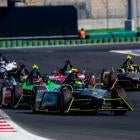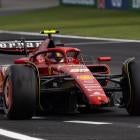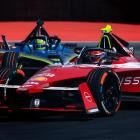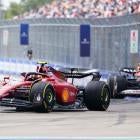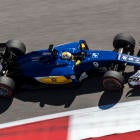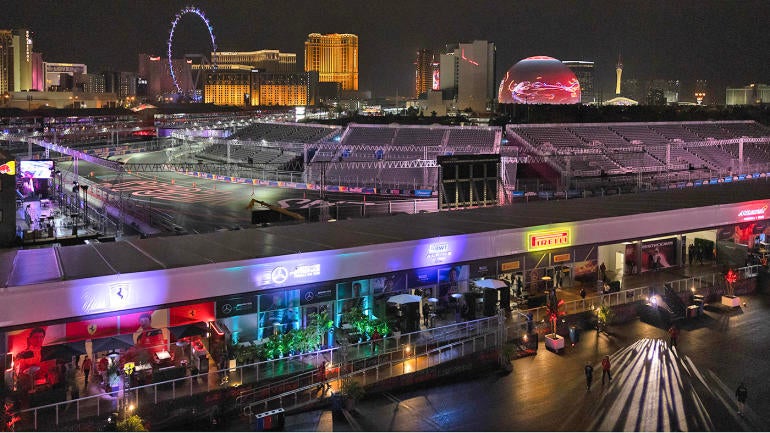
To say the Formula One Las Vegas Grand Prix has been one of, if not the most, anticipated events on the 2023 calendar is an understatement. Everyone -- the teams, series organizers and fans -- has been looking forward to racing under the lights of Sin City. And under the lights they will be, as all the action will take place at night, which the series is hoping will create a true spectacle of speed. Let's face it: Cars just look like they are going faster when they are under the lights at night.
There's another reason the teams and drivers have been anticipating this weekend: A new track, with nothing to use as a baseline, means the ground is level for everyone. At Ferrari, Charles Leclerc and Carlos Sainz Jr. are hoping the Las Vegas Strip Circuit will provide them with a similar racing experience to the one they had at Singapore, where Sainz won and Leclerc finished fourth. Others are saying the street course seems to be more like twisty Baku or even high-speed Monza. And more are of the opinion that tire degradation will be similar to what they experience at Monaco.
That is the peculiar situation Vegas presents. Until the drivers are taking practice laps and can get real data, the comparisons are ranging from low-downforce twisty, narrow tracks to high-speed, high-downforce ones.
"No two laps will be the same," Aston Martin's Fernando Alonso told motorsport.com. "Every lap of the track will be a little bit better than the lap before -- from FP1 to the last lap of the race. We will have to adapt to that changeable grip, so it's going to be a challenge for everyone. … We've been facing a little bit of tire overheating on the past three events [at Texas, Mexico and Brazil] and maybe here it's a little bit of the opposite. It could be that with these long straights, the tires lose a little bit of temperature."
Another wrinkle will be the fact that there are no support races for this event. Coupled with the fact that sections of the circuit will be open to normal vehicular traffic during the day, and the track is not exactly going to be rubbered in by the time the main event rolls off late Saturday night into Sunday morning in Las Vegas.
How to watch the Formula One Las Vegas Grand Prix
- Date: Sunday, Nov. 18
- Location: 3.853 mile (6.201 kilometer), 17-turn Las Vegas Strip Circuit, Las Vegas, Nevada
- Time: 1 a.m. ET
- TV: ESPN
- Stream: fubo (try for free)
What to watch for
Winding along iconic Las Vegas casino landmarks such as Caesars, the Bellagio and the Venetian, many are expecting Monaco-like conditions (regarding the track surface) and Monza-like speeds at The Strip Circuit. It will already have one thing going for it that the previous editions of the grand prix here did not have: It's going to be held at night, so Las Vegas will be on full display in all its neon brilliance. That will help keep the drivers and cars out of the sun, which can still be pretty brutal in Las Vegas even in November. Temperatures should actually be in the light jacket-wearing zone, and as long as the wind doesn't kick up across this high desert things should be fine, making the circuit free of that slippery dust and leaving the drivers not having to worry about a gust of wind catching them out.
"The surface will be a mix of the usual street asphalt, especially on the actual Strip, as well as other parts that have been completely re-asphalted for the occasion, adding another unknown element," Mario Isola, Pirelli's motorsport director, told formula1.com. "There won't be any support races and the track will be opened again to normal traffic for long chunks of the day, which means that the surface won't rubber in as usual and deliver improved grip. We're expecting the cars to run quite low levels of downforce, similar to Baku or indeed Monza, and hitting a high-top speed will be key to being competitive. All the sessions will take place at night, with unusual ambient and track temperatures for a race weekend."
The front straight has an odd kink in it (the Turn 17 dogleg, the final curve on the circuit) and a little bit longer than a short chute for the start/finish before the cars are into the opening sequence of twisties: A compound left-hand hairpin that encompasses Turns 1 and 2 followed by a softer radius right-hander for Turn 3 and into Turn 4, where the first of two DRS zones are. This straight ends in a 45-degree right-hander (Turn 5) that leads to another soft radius left-hander for Turn 6 and the most complicated section of the circuit -- a series of quick, left-right-left turns that will tighten the field up for the short chute to a soft radius right-hander for Turn 10, an even shorter chute to the Turn 11 left-hander, and the kink at the Turn 12 left-hander that brings the field to Turn 13 and the second DRS zone. This section (Turn 12 to the 45-degree left-hander at Turn 14) is the longest, mostly straight section of the circuit and will likely see the highest speeds and a good amount of drag racing passes. Turn 14 immediately delivers the car to the soft Turn 15 right-hander that empties at the soft radius Turn 16 and the straight to the dogleg Turn 17 and the front straight.
Pirelli will be bringing the softest range in their catalog to Las Vegas: The C3 white (hardest of the three compounds available), the C4 yellow (the medium) and the C5 red (softest). The greens (intermediates) and blues (rain) will also be available, should the weather call for them. Unlikely, but this being Vegas there is bound to be a sportbook taking a bet on that somewhere in the city. These compounds were last used at Mexico City, and until they get out on the track for practice the teams are expecting the same kind of wear. Max Verstappen made a three-stop strategy work at Mexico City, so could that be the road to victory at Las Vegas? Lewis Hamilton and Charles Leclerc finished 2-3 to Verstappen at Mexico City using a two-stop strategy (albeit 13-plus seconds behind), so we'll have to tune in to see.








